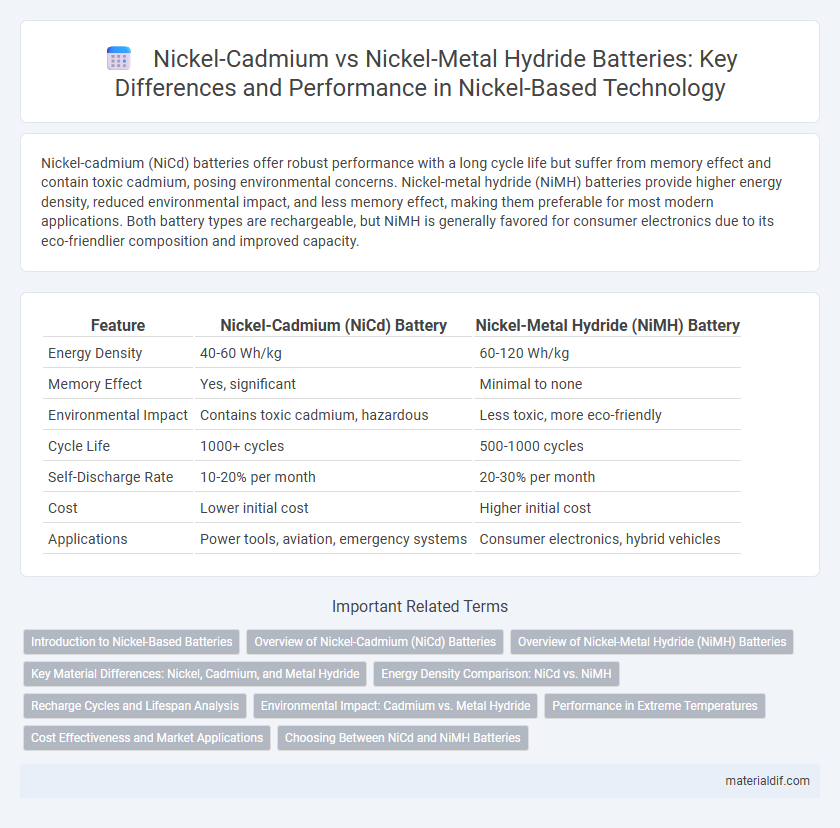Nickel-cadmium (NiCd) batteries offer robust performance with a long cycle life but suffer from memory effect and contain toxic cadmium, posing environmental concerns. Nickel-metal hydride (NiMH) batteries provide higher energy density, reduced environmental impact, and less memory effect, making them preferable for most modern applications. Both battery types are rechargeable, but NiMH is generally favored for consumer electronics due to its eco-friendlier composition and improved capacity.
Table of Comparison
| Feature | Nickel-Cadmium (NiCd) Battery | Nickel-Metal Hydride (NiMH) Battery |
|---|---|---|
| Energy Density | 40-60 Wh/kg | 60-120 Wh/kg |
| Memory Effect | Yes, significant | Minimal to none |
| Environmental Impact | Contains toxic cadmium, hazardous | Less toxic, more eco-friendly |
| Cycle Life | 1000+ cycles | 500-1000 cycles |
| Self-Discharge Rate | 10-20% per month | 20-30% per month |
| Cost | Lower initial cost | Higher initial cost |
| Applications | Power tools, aviation, emergency systems | Consumer electronics, hybrid vehicles |
Introduction to Nickel-Based Batteries
Nickel-cadmium (NiCd) batteries consist of a nickel oxide hydroxide cathode and a cadmium anode, offering high discharge rates and long cycle life but suffering from memory effect and environmental toxicity due to cadmium. Nickel-metal hydride (NiMH) batteries use a nickel oxide hydroxide cathode and a hydrogen-absorbing alloy anode, providing higher energy density, reduced environmental impact, and less pronounced memory effect compared to NiCd. Both battery types leverage nickel's electrochemical properties for rechargeable power, with NiMH increasingly favored in consumer electronics and hybrid vehicles due to better sustainability and capacity.
Overview of Nickel-Cadmium (NiCd) Batteries
Nickel-Cadmium (NiCd) batteries are rechargeable energy storage devices known for their robustness and long cycle life, commonly used in portable electronics and power tools. They utilize nickel oxide hydroxide and metallic cadmium electrodes, providing reliable performance under extreme temperatures and high discharge rates. Despite their durability, NiCd batteries suffer from memory effect and contain toxic cadmium, leading to environmental concerns and limited modern usage compared to Nickel-Metal Hydride (NiMH) alternatives.
Overview of Nickel-Metal Hydride (NiMH) Batteries
Nickel-metal hydride (NiMH) batteries offer higher energy density and are more environmentally friendly compared to nickel-cadmium (NiCd) batteries, reducing the risk of toxic cadmium pollution. NiMH batteries provide improved capacity for longer usage times, making them ideal for consumer electronics and electric vehicles. Their lower memory effect enhances rechargeability and lifespan, positioning NiMH as a preferred choice in sustainable battery technology.
Key Material Differences: Nickel, Cadmium, and Metal Hydride
Nickel-cadmium batteries use cadmium as the negative electrode material, which provides excellent cycle life but raises environmental concerns due to its toxicity. Nickel-metal hydride batteries replace cadmium with a metal hydride alloy, reducing toxicity and offering higher energy density. Both battery types utilize nickel oxyhydroxide as the positive electrode but differ significantly in the negative electrode materials, impacting performance, environmental impact, and recycling processes.
Energy Density Comparison: NiCd vs. NiMH
Nickel-metal hydride (NiMH) batteries offer significantly higher energy density compared to nickel-cadmium (NiCd) batteries, typically around 60-120 Wh/kg versus 45-80 Wh/kg for NiCd. This higher energy density allows NiMH batteries to store more energy within the same weight and volume, making them preferable for applications requiring longer runtime. Conversely, NiCd batteries maintain advantages in durability and performance in extreme temperatures despite their lower energy density.
Recharge Cycles and Lifespan Analysis
Nickel-cadmium (NiCd) batteries typically offer around 1,000 to 1,500 recharge cycles, while nickel-metal hydride (NiMH) batteries range from 500 to 1,000 cycles, depending on usage and maintenance. NiCd batteries exhibit superior longevity under high-drain applications and endure deep discharge better, contributing to a longer overall lifespan compared to NiMH batteries. NiMH batteries provide higher energy density but may degrade faster with frequent full discharge cycles, impacting their long-term durability.
Environmental Impact: Cadmium vs. Metal Hydride
Nickel-cadmium (NiCd) batteries contain cadmium, a toxic heavy metal with significant environmental hazards, including soil and water contamination if improperly disposed of. Nickel-metal hydride (NiMH) batteries use metal hydride alloys, which are less harmful and more environmentally friendly, reducing the risk of pollution and toxicity. Recycling protocols for NiMH batteries are simpler and safer, making them a preferred choice for reducing ecological impact compared to NiCd batteries.
Performance in Extreme Temperatures
Nickel-metal hydride (NiMH) batteries exhibit superior performance in extreme temperatures compared to Nickel-cadmium (NiCd) batteries, maintaining higher capacity and efficiency in both cold and hot environments. NiMH cells provide enhanced charge retention and slower capacity degradation at subzero temperatures, making them suitable for applications exposed to harsh climatic conditions. NiCd batteries experience significant voltage drops and reduced cycle life under temperature extremes, limiting their reliability in demanding environments.
Cost Effectiveness and Market Applications
Nickel-metal hydride (NiMH) batteries offer greater cost-effectiveness compared to nickel-cadmium (NiCd) batteries due to higher energy density and longer cycle life, reducing replacement frequency. NiMH batteries dominate market applications in hybrid electric vehicles, consumer electronics, and power tools, while NiCd batteries remain in niche industrial and aviation sectors where robustness against memory effect is critical. The declining use of cadmium, driven by environmental regulations, further limits NiCd market share in favor of NiMH technology.
Choosing Between NiCd and NiMH Batteries
Nickel-cadmium (NiCd) batteries offer robust performance and long cycle life but suffer from memory effect and contain toxic cadmium, posing environmental concerns. Nickel-metal hydride (NiMH) batteries provide higher capacity with less environmental impact, making them suitable for high-drain devices despite a shorter cycle lifespan. Selecting between NiCd and NiMH batteries depends on application requirements, balancing durability, energy density, and ecological considerations.
Nickel-cadmium battery vs Nickel-metal hydride battery Infographic

 materialdif.com
materialdif.com